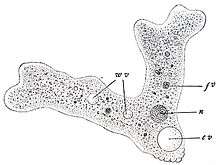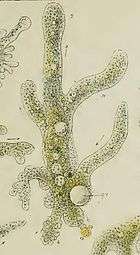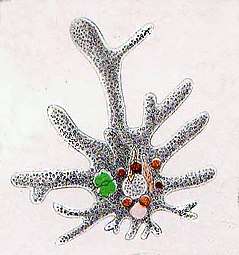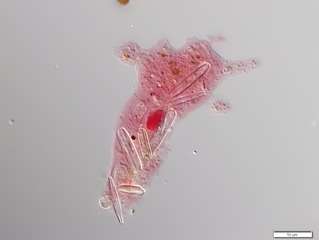Amoeba proteus
Amoeba proteus (type species of Amoeba), of which Chaos diffluens is one of many synonyms,[1][2] is a large amoeba related to another genus of giant amoebae, Chaos. It can be bought at science supply stores.
| Amoeba proteus | |
|---|---|
 | |
| Scientific classification | |
| Domain: | Eukaryota |
| Phylum: | |
| Class: | |
| Order: | |
| Family: | |
| Genus: | |
| Species: | A. proteus |
| Binomial name | |
| Amoeba proteus | |
| Synonyms | |
|
Volvox proteusPallas, 1766
| |
This protozoon uses extensions called pseudopodia to move and to eat smaller unicellular organisms. Food is enveloped inside the cell's cytoplasm in a food vacuole,[3] where they are slowly broken down by enzymes. Amoeba proteus is very well known for its extending pseudopodia. It occupies freshwater environments and feeds on other protozoans, algae, rotifers, and even other smaller amoebae. A. proteus is colourless, but may have coloured inclusions derived from its food.
A. proteus possesses a thick-walled nucleus containing granular chromatin, and is therefore a eukaryote. Its membrane includes a phospholipid bilayer similar to other eukaryotic organisms.
History
The first description of this amoeba is probably that of August Johann Rösel von Rosenhof who, in 1755, published drawings of an amoeboid protozoan he called the "little Proteus".[4] Subsequently, various authors assigned Rösel's organism and other amoeboid protozoa various names: Carl Linnaeus termed Rösel's organism Chaos protheus in 1758.[4] Otto Friedrich Müller referred to it as Proteus diffluens in 1786.[4] In 1878, Joseph Leidy proposed the current name Amoeba proteus to describe Rösel's Proteus, Proteus diffluens, and another described amoeba Amoeba princeps.[4][5]
Reproduction
Although Amoeba proteus has most of the key proteins associated with sexual processes (as do other amoebae) [6]) no evidence of meiosis or sexual activity has been reported.
Image gallery

 Amoeba proteus showing food vacuoles and ingested diatom
Amoeba proteus showing food vacuoles and ingested diatom Amoeba proteus with ingested diatoms
Amoeba proteus with ingested diatoms
Video gallery
See also
References
- http://jcs.biologists.org/content/joces/s2-71/282/239.full.pdf
- https://www.uniprot.org/taxonomy/5775
- Nishihara E, Shimmen T, Sonobe S (December 2004). "Functional characterization of contractile vacuole isolated from Amoeba proteus". Cell Struct. Funct. 29 (4): 85–90. doi:10.1247/csf.29.85. PMID 15665503.
- Lorch J (1973). "Some Historical Aspects of Amoeba Studies". In Jeon K (ed.). The Biology of Amoeba (1 ed.). ISBN 9780323144049.
- Joseph Leidy (1878). "Amoeba proteus". The American Naturalist. 12 (4): 235–238. doi:10.1086/272082.
- Hofstatter PG, Brown MW, Lahr DJ (November 2018). "Comparative Genomics Supports Sex and Meiosis in Diverse Amoebozoa". Genome Biol Evol. 10 (11): 3118–3128. doi:10.1093/gbe/evy241. PMC 6263441. PMID 30380054.